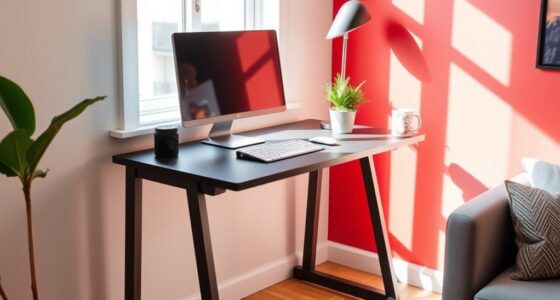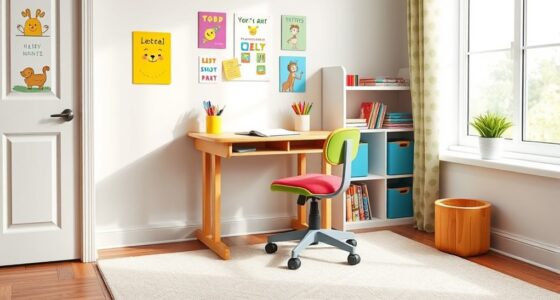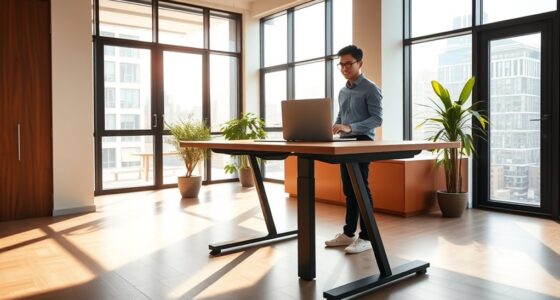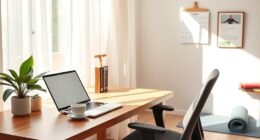Standing desks are more than just a trend; they’re changing how workplaces promote health and well-being. By reducing sitting time, they can improve posture, boost circulation, and lower back pain, backed by scientific evidence. However, standing all day isn’t ideal and can cause discomfort or circulation issues. The key is using them correctly, switching between sitting and standing, and following best practices. If you want to get the full picture, explore further for helpful tips and insights.
Key Takeaways
- Standing desks promote better posture and circulation, supporting overall health when used properly.
- They can reduce sitting time, lowering risks of musculoskeletal and cardiovascular issues.
- Prolonged standing without breaks may cause discomfort; proper ergonomics and movement are essential.
- Adjustable models allow personalized comfort, making them effective health tools if integrated into routines.
- While beneficial, standing desks are not a complete solution; balanced sitting and standing are necessary for optimal health.
The Rise of Standing Desks: Trends and Adoption
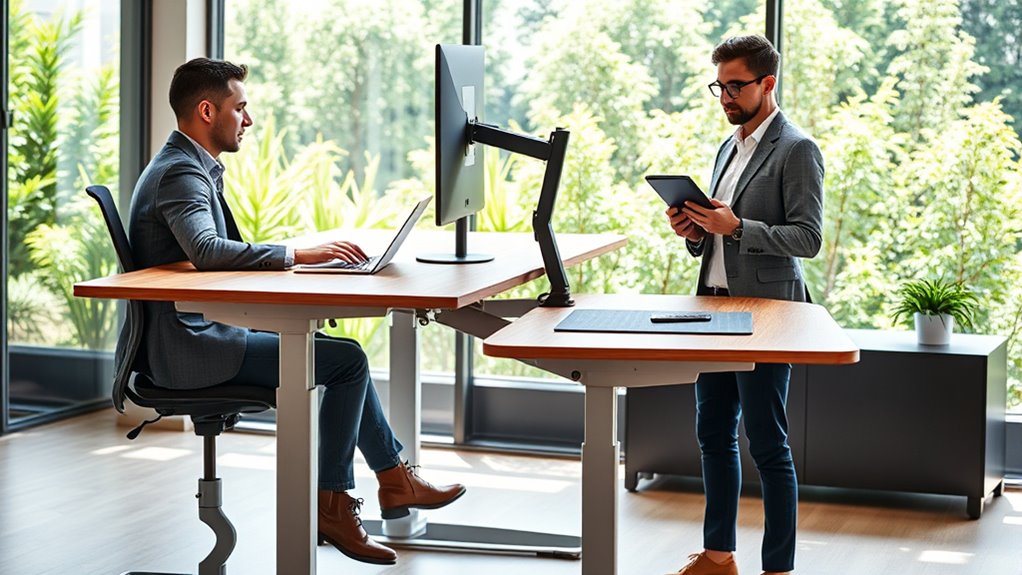
In recent years, standing desks have gained significant popularity as more people recognize the health benefits of reducing sitting time. This shift has influenced desk design, encouraging manufacturers to create adjustable and ergonomic options that suit diverse workspaces. As organizations adopt standing desks, workplace culture begins to evolve, emphasizing flexibility and employee well-being. Companies now see the value in fostering environments where standing is normalized, helping to boost productivity and morale. The trend reflects a broader movement toward healthier work habits, with many workplaces redesigning areas to accommodate standing options. This adoption isn’t just about individual health but also about creating a forward-thinking, dynamic culture that prioritizes employee comfort and engagement. The rise of standing desks marks a significant shift in how we approach workspaces today.
Health Benefits Supported by Scientific Evidence

Scientific studies consistently show that standing desks offer tangible health advantages. One major benefit is promoting an ergonomic posture, which helps reduce musculoskeletal strain and discomfort caused by prolonged sitting. By standing, you encourage better spinal alignment and less pressure on your lower back, decreasing the risk of pain and injury. Additionally, standing desks positively impact cardiovascular health. Standing encourages more movement throughout the day, which can improve circulation and lower blood pressure. Research indicates that replacing sitting time with standing can lead to modest improvements in heart health markers. Incorporating adjustable features can further enhance these benefits by allowing personalized comfort adjustable features. While standing isn’t a cure-all, these benefits demonstrate how adopting a standing desk can support your overall well-being. Scientific evidence suggests that incorporating standing into your routine can be a simple yet effective way to enhance your health.
Potential Risks and Drawbacks of Standing for Long Periods

While standing desks offer notable health benefits, standing for extended periods can also pose risks. Prolonged standing may lead to circulatory issues, such as blood pooling in the legs, which can cause swelling and discomfort. You might also experience joint discomfort, especially in your knees, hips, or lower back, from maintaining the same posture too long. These issues can become persistent if you don’t take breaks or shift your stance regularly. Standing without movement puts extra strain on your muscles and joints, increasing the risk of fatigue and pain. Incorporating movement and periodic sitting can help mitigate these potential drawbacks and keep your body comfortable. Additionally, using appropriate footwear and supportive mats can reduce some of the strain associated with prolonged standing.
Best Practices for Using Standing Desks Effectively

To maximize the benefits of a standing desk and minimize discomfort, adopting best practices for its use is essential. Focus on maintaining proper posture alignment by keeping your shoulders relaxed, elbows close to your sides, and your monitor at eye level. This helps prevent strain and promotes comfort. Remember to vary your activity regularly; standing for extended periods can cause fatigue. Incorporate short sitting breaks or gentle movement every 30 to 60 minutes. Use an anti-fatigue mat if standing for long stretches. Adjust your desk height to guarantee your wrists remain straight and your feet are flat on the floor. Staying mindful of posture and switching between sitting and standing positions will help you avoid fatigue and maximize health benefits. Additionally, participating in remote hackathons can foster continuous learning and innovative thinking that complements a healthy work routine.
Comparing Standing Desks to Other Ergonomic Solutions
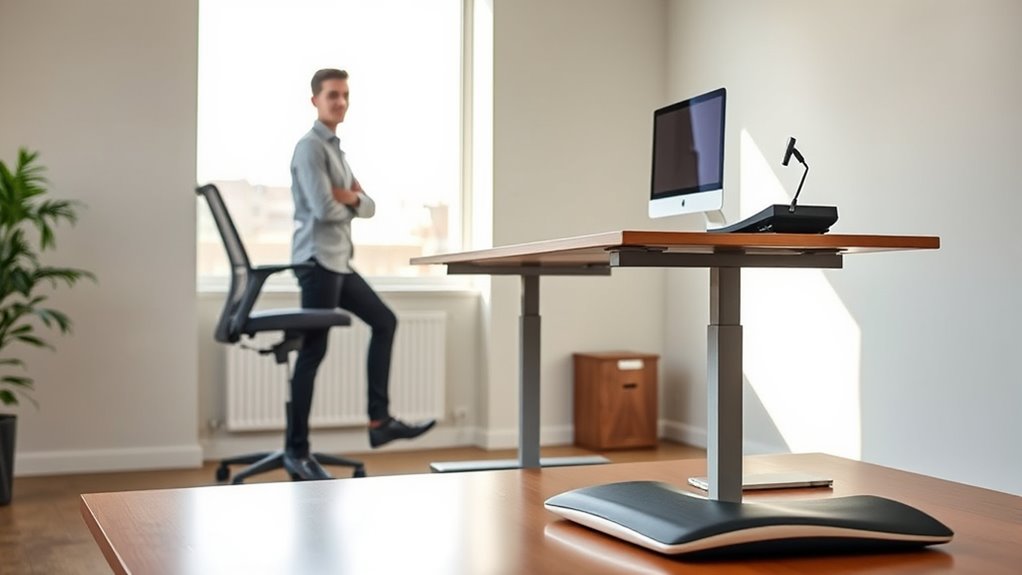
When choosing ergonomic solutions, you’ll want to consider flexibility and adjustability to suit your workspace and comfort needs. Cost and accessibility also play a big role in deciding which option fits your budget and lifestyle. Comparing standing desks to other solutions helps you find the best fit for your work environment. Incorporating features like adjustable height can further enhance comfort and promote healthier sitting and standing habits throughout the day.
Flexibility and Adjustability
Standing desks offer a high level of flexibility and adjustability, making it easy for you to switch between sitting and standing positions throughout the day. Their ergonomic design ensures you can customize the height to fit your body, promoting user comfort and reducing strain. Unlike fixed desks, which limit your movement, adjustable standing desks allow smooth progressions, helping you maintain proper posture. Some models feature programmable height settings, so you can quickly switch to your preferred positions without hassle. This adaptability makes standing desks a versatile solution for different work tasks and personal preferences. Overall, their flexibility enhances your comfort and supports a more dynamic, healthier work environment, setting them apart from more rigid ergonomic solutions. Additionally, awareness of market trends and insights can help you choose the most effective and up-to-date standing desk options.
Cost and Accessibility
Compared to other ergonomic solutions like specialized chairs or sit-stand workstations, standing desks can vary widely in cost and accessibility. Price considerations play a big role in your decision, as basic models may be affordable but lack durability or features, while premium options can be costly. Accessibility challenges also come into play, especially if you have limited space or budget constraints. Not everyone can easily invest in a high-end standing desk, making it harder to access these health benefits. Additionally, some options require assembly or adjustments that may not be straightforward for all users. Ultimately, balancing cost and accessibility is key to finding a standing desk solution that fits your needs without breaking the bank. Understanding ergonomic benefits can help you make an informed choice that aligns with your health goals and financial situation.
Making an Informed Decision: Are Standing Desks Right for You?

Deciding whether a standing desk is right for you involves evaluating your specific needs, habits, and health considerations. Think about how often you stand versus sit during your workday and whether ergonomic accessories, like anti-fatigue mats or adjustable monitor arms, could improve your comfort. Also, check your workplace policies—some companies encourage standing desks, while others may have restrictions or limited options. Consider any health issues, such as back pain or joint problems, that might influence your choice. Ultimately, an adjustable desk allows you to switch between sitting and standing, offering flexibility. Exploring the versatility of different models can help you find a desk that suits your lifestyle. Making an informed decision means weighing these factors carefully. If you’re committed to improving your posture and comfort, a standing desk could be a worthwhile investment.
Frequently Asked Questions
How Do Standing Desks Impact Mental Focus and Productivity?
Standing desks can boost your mental focus and productivity by promoting ergonomic posture, which reduces discomfort and distractions. When you stand, you’re more likely to experience increased mental clarity and alertness, helping you stay engaged with your tasks. Switching between sitting and standing encourages movement, preventing fatigue. Overall, these desks support a healthier work environment, making it easier for you to stay focused and perform at your best throughout the day.
What Are the Long-Term Ergonomic Benefits of Standing Desks?
You might think long-term ergonomic benefits are just a bonus, but standing desks actually encourage better ergonomic posture and muscle engagement over time. By switching between sitting and standing, you help prevent strain and promote alignment, reducing aches and injuries. So, instead of just a trendy gadget, they can be a smart investment in your health, helping you stand tall and stay comfortable for years to come.
Can Standing Desks Help With Specific Health Conditions?
Standing desks can help with specific health conditions like back pain, obesity, and cardiovascular issues by encouraging movement and reducing prolonged sitting. Using ergonomic accessories, such as adjustable keyboard trays and anti-fatigue mats, boosts comfort and support. If you have allergy concerns, choosing desks with easy-to-clean surfaces can minimize dust buildup. Incorporating standing desks into your routine may improve overall well-being and help manage certain health conditions effectively.
How Do Standing Desks Compare in Cost to Traditional Desks?
Think of cost comparison like weighing a feather against a brick—you’ll find standing desks often cost more upfront than traditional ones. However, affordability options like adjustable models or budget-friendly brands can make them accessible. While they might require a larger initial investment, many see the benefits as worth the cost, especially considering potential health savings. So, your choice depends on your budget and long-term wellness goals.
Are There Customizable Options for Different Work Environments?
You’ll find many standing desks with customizable options for your work environment. Look for adjustable features, so you can easily change height and position to suit your needs. Aesthetic options also play a role, allowing you to choose designs that match your workspace decor. These customization options make it simple to create a comfortable, productive setup that fits your style and health goals.
Conclusion
Now that you’ve seen the benefits and risks, it’s clear standing desks can be a health game-changer if used wisely. But are they the perfect solution for everyone? The key is to find a balance that works for you, incorporating movement and proper ergonomics. So, why not give standing desks a try and see how they fit into your routine? After all, your health deserves a proactive approach—are you ready to make the switch?


